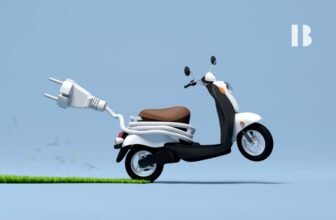Introduction

The air pollution crisis in India has reached alarming levels, with the World Health Organization (WHO) ranking it as one of the world’s most polluted countries. This is due to a variety of sources including industrialization, the burning of coal and biomass, and vehicular emissions. These pollutants not only cause poor air quality but also lead to a range of health impacts including respiratory illnesses, and increased risk of stroke, heart attack, and cancer.
Electric scooters may offer a potential solution to reduce air pollution and carbon emissions in India. Electric scooters are powered by rechargeable batteries instead of gasoline, meaning they produce no direct emissions when in operation.
They can also be charged using renewable energy sources such as solar or wind power, further reducing the environmental impacts associated with their use. Additionally, electric scooters are significantly quieter than gasoline-powered vehicles, creating less noise pollution while still providing efficient transportation.
The Indian government has implemented various measures to promote the use of electric scooters among citizens. This includes subsidies on electric scooter purchases as well as incentives for charging station installation across cities. The government has also put forth plans to make all public transport vehicles electric by 2030, in an effort to replace the diesel-powered buses that contribute heavily to urban air pollution.
India is well-positioned to leverage electric scooters and other zero-emission technologies as part of its efforts to reduce air pollution. With these initiatives already underway and more planned for the future, India could become an example for other countries looking to reduce their own air pollution levels in an environmentally friendly way.
The positive effects of electric scooters could extend beyond just reducing air pollution and carbon emissions. They offer a cost-effective option for transportation compared to other modes such as cars or motorcycles – helping to reduce congestion while still being able to move people efficiently. Additionally, they are extremely light and portable, making them ideal for those living in densely populated areas or far away from charging stations.
Finally, electric scooters have the potential to create jobs related to manufacturing, maintenance, and operations – which could help stimulate economic growth in India and give more people access to better job opportunities.
With initiatives already underway from the government’s side as well as more planned for the future, India could become a prime example for other countries looking to reduce their own air pollution levels in an environmentally friendly way.
Current State of Air Pollution in India
Air pollution in India is primarily caused by emissions from vehicles, industrial activities, and the burning of fossil fuels. This pollution has detrimental effects on public health, the environment, and the economy. According to the World Air Quality Report, several Indian cities consistently rank among the most polluted globally. And in 2019, the WHO reported that India is home to 14 of the 15 most polluted cities in the world.
Air pollution has serious impacts on public health and contributes to an estimated 1.2 million deaths each year in India. It increases respiratory problems such as asthma, resulting in increased visits to hospital emergency rooms and clinics for treatment. Air pollution is also linked to a range of other health impacts including respiratory illnesses, and increased risk of stroke, heart attack, and cancer.
Environmental damage caused by air pollution in India includes acid rain, reduced visibility due to haze and smog, global warming caused by the emission of greenhouse gases such as carbon dioxide, and ecosystem damage due to toxic substances released into the atmosphere.
The economic costs of air pollution in India are huge, with estimates ranging from 6-8% of India’s GDP per year. Air pollution-related health costs, such as medical expenses and lost productivity due to absenteeism, have been estimated at $13 billion annually.
India has implemented a number of measures to reduce air pollution levels, with the main focus on curbing emissions from vehicles and industrial activities. These include the introduction of stricter vehicle emission standards, the use of cleaner fuels, and the development of renewable sources of energy. The Indian government is also taking steps to raise awareness among its citizens about the dangers of air pollution and to encourage the use of public transport.
Electric scooters have been identified as a potential solution for India’s growing air pollution problem, providing an efficient and cost-effective mode of transport with zero emissions. If properly implemented, electric scooters could help reduce air pollution levels while creating job opportunities related to their maintenance and operations. This could, in turn, help to stimulate economic growth and improve public health in India.
Electric Scooters as an Eco-Friendly Alternative
How Electric Scooters Work
Electric scooters are powered by rechargeable batteries, producing zero tailpipe emissions. In comparison, traditional gasoline-powered scooters emit pollutants such as carbon monoxide, hydrocarbons, and particulate matter. Electric scooters not only help reduce air pollution but also offer benefits like lower operating costs and reduced noise pollution.
Emissions Comparison: Electric vs. Gasoline-Powered Scooters
| Emission Type | Electric Scooters | Gasoline-Powered Scooters |
|---|---|---|
| Carbon Dioxide (CO2) | Zero tailpipe emissions | Emit CO2 from combustion |
| Carbon Monoxide (CO) | Zero tailpipe emissions | Emit CO from incomplete combustion |
| Hydrocarbons (HC) | Zero tailpipe emissions | Emit HC from combustion and evaporation |
| Nitrogen Oxides (NOx) | Zero tailpipe emissions | Emit NOx from combustion |
| Particulate Matter (PM) | Zero tailpipe emissions | Emit PM from combustion |
| Noise Pollution | Low noise levels | Higher noise levels due to combustion engine |
The Benefits of Electric Scooters
Electric scooters offer several benefits to Indian society, including:
- Reduced air pollution & improved public health: Electric scooters are much cleaner than gasoline-powered vehicles, leading to fewer emissions and improved air quality. This can reduce the risk of respiratory illnesses such as asthma and other related diseases.
- Economic growth: Electric scooter ownership can create job opportunities related to their maintenance and operations. This could help stimulate economic growth in India.
- Convenience: Electric scooters are lightweight, compact, and easy to operate. They offer a convenient, cost-effective mode of transport for people living in urban areas with limited public transportation options.
- Cost savings: Electric scooters are cheaper to own and operate than gasoline-powered vehicles over the long term, resulting in significant savings for consumers.
Implementation of Electric Scooters in India
Electric Scooter Usage in India: Current Scenario
The use of electric scooters is on the rise in India, aided by government policies and incentives like the FAME II scheme. However, challenges like inadequate charging infrastructure, high upfront costs, and range anxiety hinder widespread adoption.
Government Policies and Incentives for Electric Vehicles in India
The government has become increasingly involved in promoting the uptake of electric vehicles, providing a range of incentives and policies to encourage people to make the switch.
Incentives such as the Faster Adoption and Manufacturing of Electric Vehicles (FAME) scheme, offer subsidies on electric vehicles ranging from Rs. 6,000 to Rs 1 lakh.
In addition, the National Clean Mobility (NCM) program provides an additional subsidy of up to Rs 30,000 for two-wheelers, while four-wheelers are eligible for a subsidy of up to Rs 1.5 lakhs
In order to encourage the development of charging infrastructure in India, the government has also introduced various policies such as allowing open-access charging and providing special incentives for setting up public charging points. The government has also provided tax exemptions for EVs along with preferential parking fees in select locations across India.
There is no denying that electric vehicles are still in the early stages of development in India. However, with strong government policies and incentives in place, we can expect to see a boom in the electric vehicle market over the coming years.
What’s more, as battery technology gets better, prices come down and charging points become more widely available, electric vehicles are likely to become even more popular among Indian consumers. This will no doubt help us achieve our goals of reducing air pollution and transitioning towards a low-carbon economy. With continued support from both the government and private sector, electric vehicles have a bright future ahead of them in India.
Challenges in Adopting Electric Scooters in India
Electric scooters are becoming increasingly popular in India, but there are several challenges associated with their adoption.
Cost
The first challenge is cost. Electric scooters are more expensive than conventional gasoline-powered vehicles, and many Indian consumers may not be able to afford them. Additionally, the infrastructure needed to support electric scooters has yet to be developed in many parts of India, which can make it difficult for people to charge them up when they need to.
Safety
The second challenge is safety. Many electric scooter models have limited features for rider protection and accident avoidance compared to other forms of transportation like cars or motorcycles. In addition, some cities lack laws and regulations governing the use of electric scooters on public roads, making it difficult to ensure riders’ safety.
Maintenance
The third challenge is maintenance. Electric scooters require more frequent servicing than traditional vehicles, and some maintenance tasks can be complex or expensive. Additionally, spare parts may be difficult to find in some areas, which can make it hard to repair a damaged electric scooter quickly.
Environmental Impact
Finally, there are concerns about environmental impact. Although electric scooters produce no local emissions, they do still consume electricity generated from sources that often release pollutants into the environment.
This means that while electric scooters may still be a better option for reducing pollution in cities than gasoline-powered vehicles, their overall environmental impact must still be considered carefully before widespread adoption can take place.
Case Study: Success of Electric Scooters in Reducing Air Pollution in India
Cities like Bengaluru and Delhi have seen a surge in electric scooter usage through initiatives like Bounce and Yulu, resulting in reduced air pollution and carbon emissions.
Studies show that electric scooters can significantly contribute to cleaner air and reduced emissions when adopted on a large scale.
Conclusion
Electric scooters have a crucial role to play in reducing air pollution and carbon emissions in India. Continued expansion and adoption of electric scooters, supported by government initiatives and individual efforts, can help India combat its air pollution crisis and create a greener, healthier future.
Electric scooters present an excellent opportunity for India to reduce its air pollution and carbon emissions. However, in order for this goal to be achieved, it is essential that individuals, businesses, and governments work together to create and implement initiatives that promote the adoption of electric scooters on a large scale.







